Simon Woelfel
@simonwoelfel.bsky.social
PhD student in the Stecher lab at LMU Munich. Interested in bacterial evolution, inflammatory diseases, and all things microbiome.
Reposted by Simon Woelfel
#NewResearch
Strain displacement in microbiomes via ecological competition
@erikbakkeren.bsky.social
#microsky
www.nature.com/articles/s41...
Strain displacement in microbiomes via ecological competition
@erikbakkeren.bsky.social
#microsky
www.nature.com/articles/s41...

Strain displacement in microbiomes via ecological competition - Nature Microbiology
Mathematical modelling and experimental tests reveal principles that govern displacement of a resident strain by an invader in microbial communities.
www.nature.com
November 7, 2025 at 11:09 AM
#NewResearch
Strain displacement in microbiomes via ecological competition
@erikbakkeren.bsky.social
#microsky
www.nature.com/articles/s41...
Strain displacement in microbiomes via ecological competition
@erikbakkeren.bsky.social
#microsky
www.nature.com/articles/s41...
Reposted by Simon Woelfel
A host–pathogen arms race focused on dynamic regulation of the host epithelial barrier, wherein enteropathogenic bacteria evade ROCK-driven epithelial cell extrusion @nature.com @genentech.bsky.social
www.nature.com/articles/s41...
www.nature.com/articles/s41...

October 22, 2025 at 6:56 PM
A host–pathogen arms race focused on dynamic regulation of the host epithelial barrier, wherein enteropathogenic bacteria evade ROCK-driven epithelial cell extrusion @nature.com @genentech.bsky.social
www.nature.com/articles/s41...
www.nature.com/articles/s41...
Reposted by Simon Woelfel
How exercise promotes the immune system vs cancer, working through a gut bacteria metabolite
www.cell.com/cell/abstrac...
www.cell.com/cell/abstrac...

October 2, 2025 at 6:56 PM
How exercise promotes the immune system vs cancer, working through a gut bacteria metabolite
www.cell.com/cell/abstrac...
www.cell.com/cell/abstrac...
Reposted by Simon Woelfel
📍Paper alert 📍
Our new preprint is available on: chemrxiv.org/engage/chemr...
Here, we show the development of a GC-MS/MS method for the quantification of 120 compounds produced by gut bacteria, including SCFA, indols, organic acids, and amino acid derivatives.
Our new preprint is available on: chemrxiv.org/engage/chemr...
Here, we show the development of a GC-MS/MS method for the quantification of 120 compounds produced by gut bacteria, including SCFA, indols, organic acids, and amino acid derivatives.

Development of a GC-MS/MS method to quantify 120 gut microbiota-derived metabolites
The gut microbiota produces metabolites that are important for host physiology and have critical roles in the development of diseases, such as metabolic disorders, cardiovascular diseases, and cancer....
chemrxiv.org
September 24, 2025 at 12:21 PM
📍Paper alert 📍
Our new preprint is available on: chemrxiv.org/engage/chemr...
Here, we show the development of a GC-MS/MS method for the quantification of 120 compounds produced by gut bacteria, including SCFA, indols, organic acids, and amino acid derivatives.
Our new preprint is available on: chemrxiv.org/engage/chemr...
Here, we show the development of a GC-MS/MS method for the quantification of 120 compounds produced by gut bacteria, including SCFA, indols, organic acids, and amino acid derivatives.
Reposted by Simon Woelfel
September meant it was the Powrie labs turn to organise an institute social! We hosted “The Great Kennedy Bake Off” and had lots of tasty entries, as well as a cake decorating competition! Congratulations to our winners - Lynn for best bake and Osheen for best decorating!🍰🍪🧁
@kiroxford.bsky.social
@kiroxford.bsky.social




September 20, 2025 at 11:21 AM
September meant it was the Powrie labs turn to organise an institute social! We hosted “The Great Kennedy Bake Off” and had lots of tasty entries, as well as a cake decorating competition! Congratulations to our winners - Lynn for best bake and Osheen for best decorating!🍰🍪🧁
@kiroxford.bsky.social
@kiroxford.bsky.social
Reposted by Simon Woelfel
Hydrogen sulfide production distinguishes Salmonella from close relatives, but its biological significance remains obscure. This study uncovers the secret: Salmonella uses hydrogen sulfide production as a weapon to outcompete E. coli and gain a foothold in the gut.
www.pnas.org/doi/10.1073/...
www.pnas.org/doi/10.1073/...

September 13, 2025 at 6:32 PM
Hydrogen sulfide production distinguishes Salmonella from close relatives, but its biological significance remains obscure. This study uncovers the secret: Salmonella uses hydrogen sulfide production as a weapon to outcompete E. coli and gain a foothold in the gut.
www.pnas.org/doi/10.1073/...
www.pnas.org/doi/10.1073/...
Reposted by Simon Woelfel
Excited to share our new publication, out today in Nature! www.nature.com/articles/s41.... @kanchanj.bsky.social led this fascinating fungal-bacterial interaction project. We are grateful for our wonderful collaborators Brian Peters and David Underhill.

Commensal yeast promotes Salmonella Typhimurium virulence - Nature
Commensal Candida albicans enhances the virulence and dissemination of Salmonella enterica subsp. enterica serovar Typhimurium.
www.nature.com
September 3, 2025 at 4:32 PM
Excited to share our new publication, out today in Nature! www.nature.com/articles/s41.... @kanchanj.bsky.social led this fascinating fungal-bacterial interaction project. We are grateful for our wonderful collaborators Brian Peters and David Underhill.
Reposted by Simon Woelfel
C. albicans colonization is a susceptibility factor for disseminated Salmonella infection and arginine as a central metabolite in the cross-kingdom interaction between fungi, bacteria and host @nature.com
www.nature.com/articles/s41...
www.nature.com/articles/s41...

September 4, 2025 at 5:02 AM
C. albicans colonization is a susceptibility factor for disseminated Salmonella infection and arginine as a central metabolite in the cross-kingdom interaction between fungi, bacteria and host @nature.com
www.nature.com/articles/s41...
www.nature.com/articles/s41...
Reposted by Simon Woelfel
Very happy to share our latest publication unravelling how the #ERstress sensor ATF6 stirs up trouble (and tumors) in #colorectalcancer. ATF6 drives CRC by reshaping lipid #metabolism and the intestinal #microbiota. A huge thank you to all co-authors! #lifesciences
www.nature.com/articles/s42...
www.nature.com/articles/s42...

ATF6 activation alters colonic lipid metabolism causing tumour-associated microbial adaptation - Nature Metabolism
The transcription factor ATF6 causes an enrichment in long-chain fatty acids in the colonic epithelium, which leads to changes in the gut microbiota and contributes to the development of colorectal ca...
www.nature.com
September 2, 2025 at 7:01 PM
Very happy to share our latest publication unravelling how the #ERstress sensor ATF6 stirs up trouble (and tumors) in #colorectalcancer. ATF6 drives CRC by reshaping lipid #metabolism and the intestinal #microbiota. A huge thank you to all co-authors! #lifesciences
www.nature.com/articles/s42...
www.nature.com/articles/s42...
Reposted by Simon Woelfel
ATF6 activation alters colonic lipid metabolism causing tumor-associated microbial adaptation @natmetabolism.nature.com
www.nature.com/articles/s42...
www.nature.com/articles/s42...

September 1, 2025 at 6:18 PM
ATF6 activation alters colonic lipid metabolism causing tumor-associated microbial adaptation @natmetabolism.nature.com
www.nature.com/articles/s42...
www.nature.com/articles/s42...
Reposted by Simon Woelfel
Veillonella promotes C. diff infection in Crohn’s disease
Oral commensal Veillonella promotes C. difficile germination by disrupting bile acid recycling. Veillonella LPS activates signaling to suppress bile acid transporter, preventing bile acid reabsorption
www.cell.com/cell-host-mi...
Oral commensal Veillonella promotes C. difficile germination by disrupting bile acid recycling. Veillonella LPS activates signaling to suppress bile acid transporter, preventing bile acid reabsorption
www.cell.com/cell-host-mi...

Veillonella intestinal colonization promotes C. difficile infection in Crohn’s disease
Yang et al. identify the oral commensal Veillonella as a key driver of Clostridioides
difficile infection in Crohn’s disease. Veillonella promotes pathogen germination
by disrupting bile acid recyclin...
www.cell.com
August 25, 2025 at 7:39 PM
Veillonella promotes C. diff infection in Crohn’s disease
Oral commensal Veillonella promotes C. difficile germination by disrupting bile acid recycling. Veillonella LPS activates signaling to suppress bile acid transporter, preventing bile acid reabsorption
www.cell.com/cell-host-mi...
Oral commensal Veillonella promotes C. difficile germination by disrupting bile acid recycling. Veillonella LPS activates signaling to suppress bile acid transporter, preventing bile acid reabsorption
www.cell.com/cell-host-mi...
Reposted by Simon Woelfel
#NewResearch
Gut bacteria degrade uric acid using a selenium-dependent enzyme via a previously unrecongnised anaerobic pathway which provides them a competitive advantage in the gut.
#MicroSky #Metabolism 🦠
www.nature.com/articles/s41...
Gut bacteria degrade uric acid using a selenium-dependent enzyme via a previously unrecongnised anaerobic pathway which provides them a competitive advantage in the gut.
#MicroSky #Metabolism 🦠
www.nature.com/articles/s41...
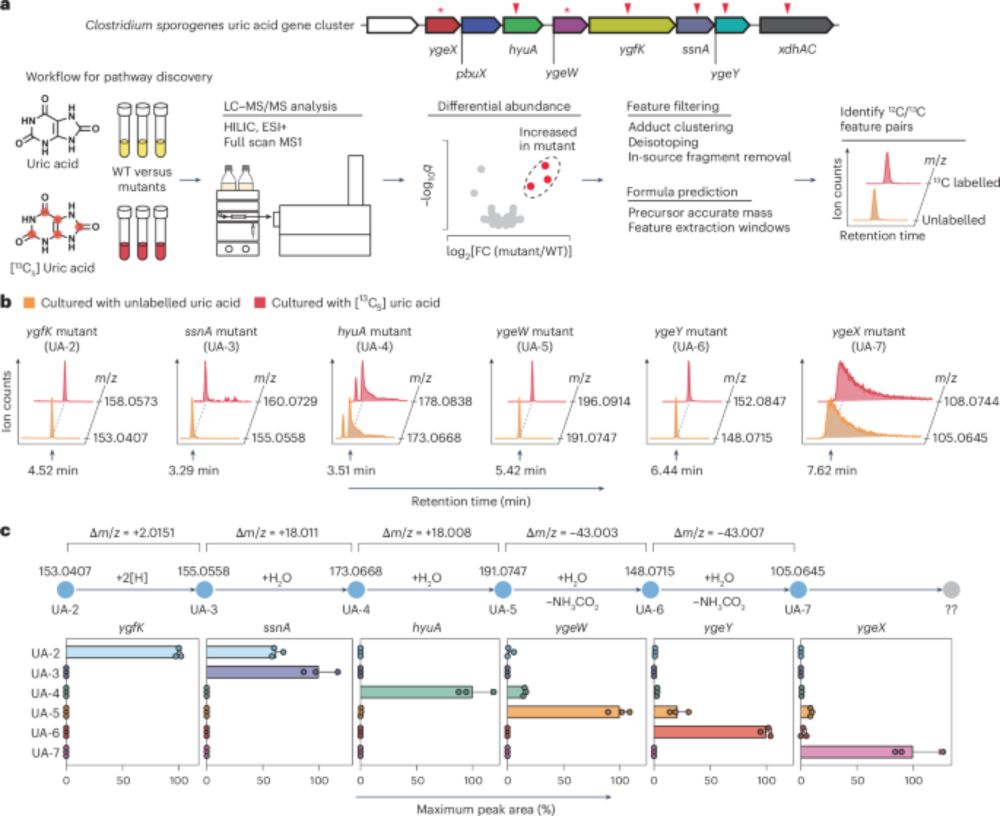
Gut bacteria degrade purines via the 2,8-dioxopurine pathway - Nature Microbiology
Utilizing a selenium-dependent enzyme, gut bacteria degrade uric acid via a previously unrecognized anaerobic pathway which gives them a competitive advantage in the gut.
www.nature.com
August 7, 2025 at 6:33 PM
#NewResearch
Gut bacteria degrade uric acid using a selenium-dependent enzyme via a previously unrecongnised anaerobic pathway which provides them a competitive advantage in the gut.
#MicroSky #Metabolism 🦠
www.nature.com/articles/s41...
Gut bacteria degrade uric acid using a selenium-dependent enzyme via a previously unrecongnised anaerobic pathway which provides them a competitive advantage in the gut.
#MicroSky #Metabolism 🦠
www.nature.com/articles/s41...
Reposted by Simon Woelfel
Amino acid competition shapes A. baumannii gut carriage
Acinetobacter baumannii uses ornithine to compete w/ microbiota & persist in gut. Amino acid supplementation & differences in diet promote A. baumannii gut colonization in mice & humans
@laurenpalmer.bsky.social
www.cell.com/cell-host-mi...
Acinetobacter baumannii uses ornithine to compete w/ microbiota & persist in gut. Amino acid supplementation & differences in diet promote A. baumannii gut colonization in mice & humans
@laurenpalmer.bsky.social
www.cell.com/cell-host-mi...
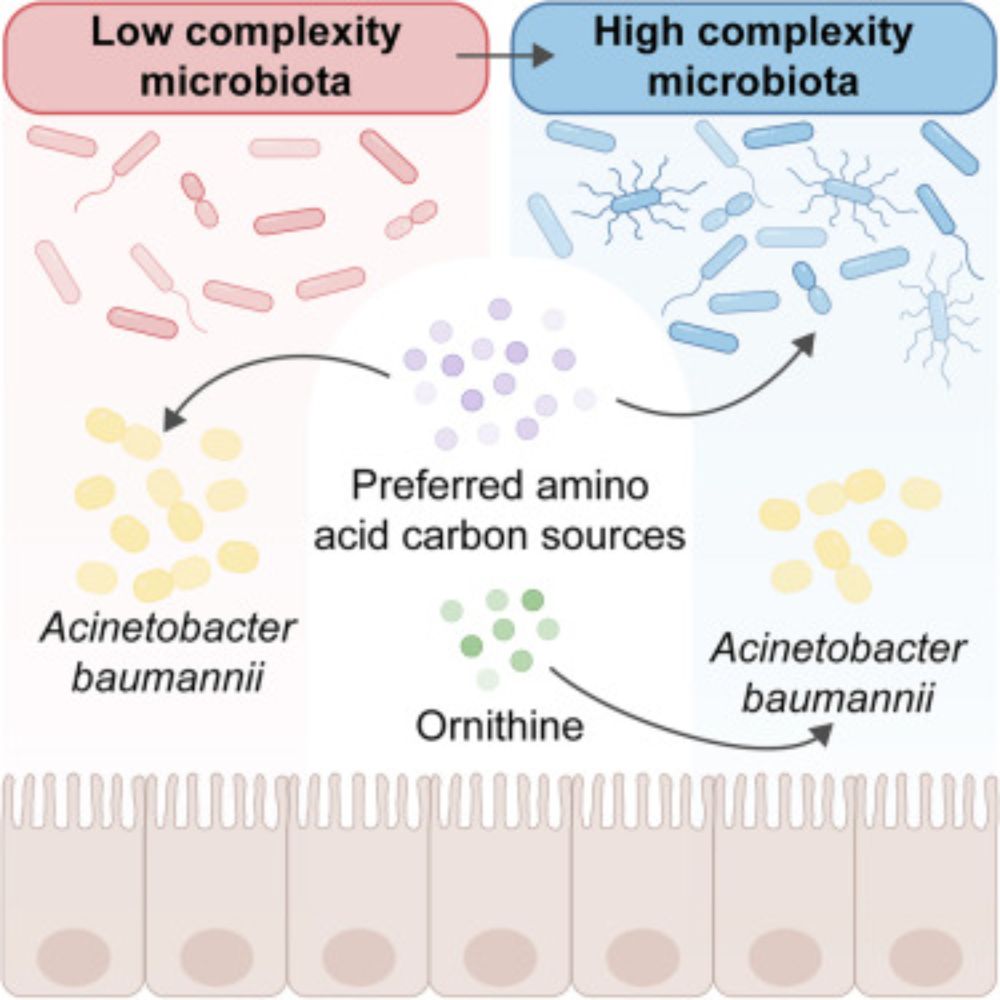
Amino acid competition shapes Acinetobacter baumannii gut carriage
Ren and Clark et al. show that Acinetobacter baumannii uses ornithine to compete with
the resident microbiota and persist in the gut. Additional evidence demonstrates that
amino acid supplementation a...
www.cell.com
August 4, 2025 at 7:54 PM
Amino acid competition shapes A. baumannii gut carriage
Acinetobacter baumannii uses ornithine to compete w/ microbiota & persist in gut. Amino acid supplementation & differences in diet promote A. baumannii gut colonization in mice & humans
@laurenpalmer.bsky.social
www.cell.com/cell-host-mi...
Acinetobacter baumannii uses ornithine to compete w/ microbiota & persist in gut. Amino acid supplementation & differences in diet promote A. baumannii gut colonization in mice & humans
@laurenpalmer.bsky.social
www.cell.com/cell-host-mi...
Reposted by Simon Woelfel
Reposted by Simon Woelfel
Non-antibiotics disrupt colonization resistance against enteropathogens @nature.com
www.nature.com/articles/s41...
www.nature.com/articles/s41...

July 16, 2025 at 6:26 PM
Non-antibiotics disrupt colonization resistance against enteropathogens @nature.com
www.nature.com/articles/s41...
www.nature.com/articles/s41...
Reposted by Simon Woelfel
Gut bacteria to the rescue! 🦠✨
They can shield us from harmful chemicals—and the latest study from Kiran Patil's lab (@kiranrpatil.bsky.social)
uncovers how. We’re proud to have contributed to this exciting work!
#Microbiome #Detox
www.nature.com/articles/s41...
They can shield us from harmful chemicals—and the latest study from Kiran Patil's lab (@kiranrpatil.bsky.social)
uncovers how. We’re proud to have contributed to this exciting work!
#Microbiome #Detox
www.nature.com/articles/s41...

Human gut bacteria bioaccumulate per- and polyfluoroalkyl substances - Nature Microbiology
Human gut bacteria bioaccumulate per- and polyfluoroalkyl substances (PFAS), commonly known as forever chemicals, in intracellular aggregates. Colonization of gnotobiotic mice with bioaccumulating bac...
www.nature.com
July 1, 2025 at 10:03 AM
Gut bacteria to the rescue! 🦠✨
They can shield us from harmful chemicals—and the latest study from Kiran Patil's lab (@kiranrpatil.bsky.social)
uncovers how. We’re proud to have contributed to this exciting work!
#Microbiome #Detox
www.nature.com/articles/s41...
They can shield us from harmful chemicals—and the latest study from Kiran Patil's lab (@kiranrpatil.bsky.social)
uncovers how. We’re proud to have contributed to this exciting work!
#Microbiome #Detox
www.nature.com/articles/s41...
Reposted by Simon Woelfel
It’s been a great week in Prague for the Food, Microbiota, and Immunity conference! Claire gave a great talk and Dehui won an award for her poster presentation👏☀️🦠 #FMI2025 @dehuic.bsky.social
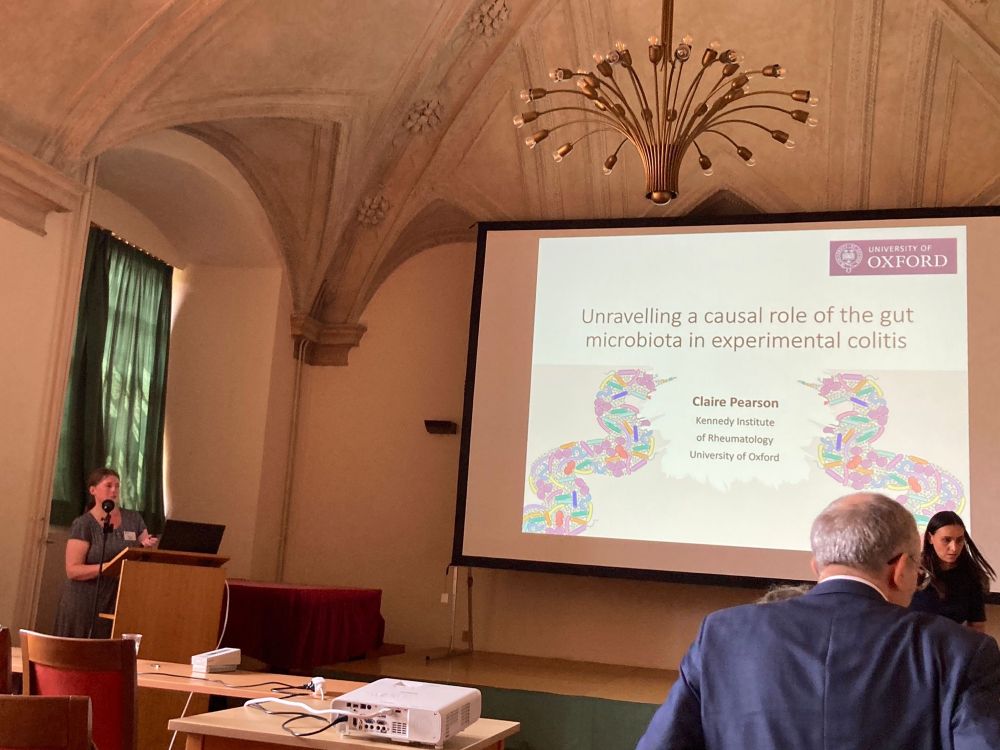

June 20, 2025 at 7:18 PM
It’s been a great week in Prague for the Food, Microbiota, and Immunity conference! Claire gave a great talk and Dehui won an award for her poster presentation👏☀️🦠 #FMI2025 @dehuic.bsky.social
Reposted by Simon Woelfel
Metabolic ecology of microbiomes: Nutrient competition, host benefits, and community engineering
Review by Erik Bakkeren, Vit Piskovsky, and Kevin R. Foster
www.cell.com/cell-host-mi...
Review by Erik Bakkeren, Vit Piskovsky, and Kevin R. Foster
www.cell.com/cell-host-mi...
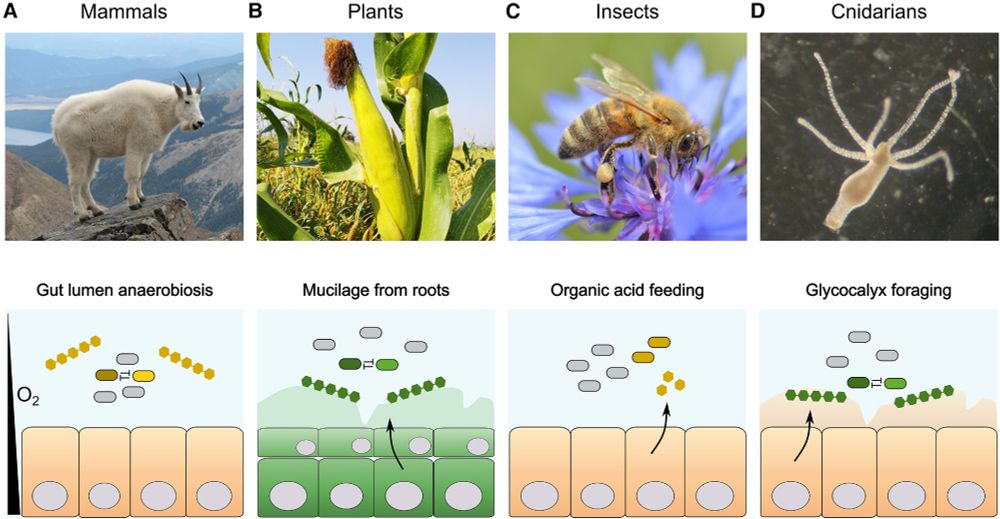
June 11, 2025 at 5:02 PM
Metabolic ecology of microbiomes: Nutrient competition, host benefits, and community engineering
Review by Erik Bakkeren, Vit Piskovsky, and Kevin R. Foster
www.cell.com/cell-host-mi...
Review by Erik Bakkeren, Vit Piskovsky, and Kevin R. Foster
www.cell.com/cell-host-mi...
Reposted by Simon Woelfel
#NatMicroPicks
Microbiota and cancer! 🦠⚕️
Microbiota-derived urocanic acid triggered bytyrosine kinase inhibitors potentiates cancer immunotherapy efficacy
#MicroSky
www.cell.com/cell-host-mi...
Microbiota and cancer! 🦠⚕️
Microbiota-derived urocanic acid triggered bytyrosine kinase inhibitors potentiates cancer immunotherapy efficacy
#MicroSky
www.cell.com/cell-host-mi...

Microbiota-derived urocanic acid triggered bytyrosine kinase inhibitors potentiates cancer immunotherapy efficacy
How tyrosine kinase inhibitors (TKIs) modulate the tumor immune microenvironment to
improve immunotherapy remains unclear. Zhang et al. find that TKI-induced M. gordoncarteri-derived
urocanic acid (UC...
www.cell.com
June 4, 2025 at 3:35 PM
#NatMicroPicks
Microbiota and cancer! 🦠⚕️
Microbiota-derived urocanic acid triggered bytyrosine kinase inhibitors potentiates cancer immunotherapy efficacy
#MicroSky
www.cell.com/cell-host-mi...
Microbiota and cancer! 🦠⚕️
Microbiota-derived urocanic acid triggered bytyrosine kinase inhibitors potentiates cancer immunotherapy efficacy
#MicroSky
www.cell.com/cell-host-mi...
Reposted by Simon Woelfel
The IL-22–oncostatin M axis promotes intestinal inflammation and tumorigenesis @natimmunol.nature.com
www.nature.com/articles/s41...
www.nature.com/articles/s41...

May 30, 2025 at 8:00 PM
The IL-22–oncostatin M axis promotes intestinal inflammation and tumorigenesis @natimmunol.nature.com
www.nature.com/articles/s41...
www.nature.com/articles/s41...
Reposted by Simon Woelfel
Me and a few of my mates got together and wrote a review on the current state of clinical translation of microbiome research.
A great summary of the state of the art for microbiome research.
www.nature.com/articles/s41...
A great summary of the state of the art for microbiome research.
www.nature.com/articles/s41...
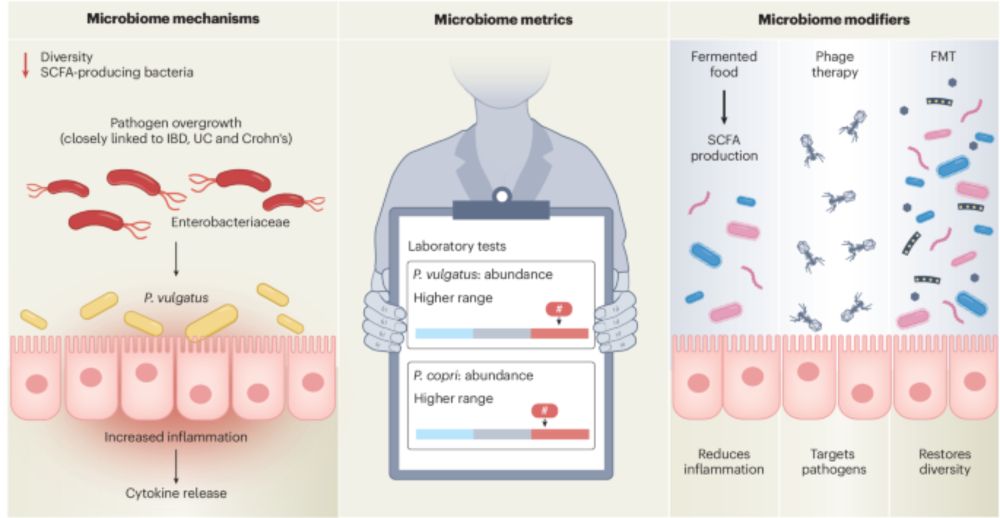
Clinical translation of microbiome research - Nature Medicine
This Review summarizes recent and compelling examples of microbiome-based interventions that are ripe for clinical adoption while also discussing the challenges and opportunities facing the field.
www.nature.com
April 11, 2025 at 2:51 PM
Me and a few of my mates got together and wrote a review on the current state of clinical translation of microbiome research.
A great summary of the state of the art for microbiome research.
www.nature.com/articles/s41...
A great summary of the state of the art for microbiome research.
www.nature.com/articles/s41...
Reposted by Simon Woelfel
Today I left Oxford @ 5am to journey to St Jean Pied de Port arriving @ 7pm. Tomorrow I start the 800km Camino walk. Many walk for religious reasons, others for personal growth. For all it is a journey both physical and personal. I do it with purpose - please share www.justgiving.com/campaign/cam...


April 5, 2025 at 8:14 PM
Today I left Oxford @ 5am to journey to St Jean Pied de Port arriving @ 7pm. Tomorrow I start the 800km Camino walk. Many walk for religious reasons, others for personal growth. For all it is a journey both physical and personal. I do it with purpose - please share www.justgiving.com/campaign/cam...
Reposted by Simon Woelfel
Highly interesting preprint on very long-lived plasma cells that could explain the remarkable stability of the gut microbiome: www.biorxiv.org/content/10.1...

Ultra long-lived plasma cells in the human small intestine produce microbiota-reactive IgA antibodies
A large fraction of the intestinal microbiota is highly coated with secretory IgA, and bacteria-specific IgA is believed to shape the composition of the microbiota. A hallmark of the adaptive immune s...
www.biorxiv.org
March 24, 2025 at 10:26 AM
Highly interesting preprint on very long-lived plasma cells that could explain the remarkable stability of the gut microbiome: www.biorxiv.org/content/10.1...
Reposted by Simon Woelfel
Congratulations Ying-Han Chen and Kim Zaldana for showing how B cells are altered when lab mice 🐭 are released outdoors! www.science.org/doi/10.1126/...
Here’s some context for the paper followed by how gov’t 💰 + other sources combine to make these types of studies possible 1/n
Here’s some context for the paper followed by how gov’t 💰 + other sources combine to make these types of studies possible 1/n

Rewilding catalyzes maturation of the humoral immune system
Releasing laboratory mice into the natural environment enhanced maturation and activation of the humoral immune system.
www.science.org
March 8, 2025 at 2:40 PM
Congratulations Ying-Han Chen and Kim Zaldana for showing how B cells are altered when lab mice 🐭 are released outdoors! www.science.org/doi/10.1126/...
Here’s some context for the paper followed by how gov’t 💰 + other sources combine to make these types of studies possible 1/n
Here’s some context for the paper followed by how gov’t 💰 + other sources combine to make these types of studies possible 1/n
Reposted by Simon Woelfel
New @thelancet.bsky.social
The importance of assessing SARS-CoV-2 anti-spike antibodies in immunocompromised individuals, from the largest prospective study of >21,000 participants; antibody presence linked with protection from infection and hospitalization
www.thelancet.com/journals/lan...
The importance of assessing SARS-CoV-2 anti-spike antibodies in immunocompromised individuals, from the largest prospective study of >21,000 participants; antibody presence linked with protection from infection and hospitalization
www.thelancet.com/journals/lan...

January 25, 2025 at 4:31 PM
New @thelancet.bsky.social
The importance of assessing SARS-CoV-2 anti-spike antibodies in immunocompromised individuals, from the largest prospective study of >21,000 participants; antibody presence linked with protection from infection and hospitalization
www.thelancet.com/journals/lan...
The importance of assessing SARS-CoV-2 anti-spike antibodies in immunocompromised individuals, from the largest prospective study of >21,000 participants; antibody presence linked with protection from infection and hospitalization
www.thelancet.com/journals/lan...


